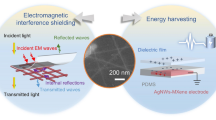Abstract
Polymeric polyurethane nanofabrics doped by zinc tetraphenylporphyrin (ZnTPP) and/or zinc phthalocyanine (ZnPc) photosensitizers were prepared by the electrospinning method and characterized by microscopic methods, steady-state and time-resolved fluorescence, and absorption spectroscopy. Nanofabrics doped by both ZnTPP and ZnPc efficiently harvest visible light to generate triplet states and singlet oxygen O2(1Δg) with a lifetime of about 15 μs in air atmosphere. The energy transfer between the excited singlet states of ZnTPP and ground states of ZnPc is described in details. All nanofabrics have bactericidal surfaces and photooxidize inorganic and organic substrates. ZnTPP and ZnPc in the polyurethane nanofabrics are less photostable than incorporated free-base tetraphenylporphyrin (TPP).









Similar content being viewed by others
References
Maisch T, Baier J, Franz B, Maier M, Landthaler M, Szeimies RM, Bäumler W (2007) The role of singlet oxygen and oxygen concentration in photodynamic inactivation of bacteria. Proc Natl Acad Sci USA 104:7223–7228 doi:10.1073/pnas.0611328104
Patrice T (2004) Photodynamic therapy. Royal Society of Chemistry, London
Lissi MV, Encias E, Lemp E, Rubio MA (1993) Singlet oxygen O2(1Δg) bimolecular processes-solvent and compartmentalization effect. Chem Rev 93:699–723 doi:10.1021/cr00018a004
Lang K, Mosinger J, Wagnerová DM (2004) Photophysical properties of porhyrinoid sensitizers non-covalently bound to host molecules; models for photodynamic therapy. Coord Chem Rev 248:321–350 doi:10.1016/j.ccr.2004.02.004
Schweitzer C, Schmidt R (2003) Physical mechanisms of generation and deactivation of singlet oxygen. Chem Rev 103:1685–1758 doi:10.1021/cr010371d
Wilkinson F, Helman WP, Ross AB (1995) Rate constants for the decay and reactions of the lowest electronically excited singlet state of molecular oxygen in solution. An expanded and revised compilation. J Phys Chem Ref Data 24:663–1021
Voeikov VL (2005) Biological oxidation: over a century of hardship for the concept of active oxygen. Cell Mol Biol 51:663–675
McGlinchey SM, McCoy CP, Gorman SP, Jones DS (2008) Key biological issues in contact lens development. Expert Rev Med Devices 5:581–590 doi:10.1586/17434440.5.5.581
Brady C, Bell SEJ, Parsons C, Gorman SP, Jones DS, McCoy CP (2007) Novel porphyrin-incorporated hydrogels for photoactive intraocular lens biomaterials. J Phys Chem B 111:527–534 doi:10.1021/jp066217i
Mosinger J, Jirsák O, Kubát P, Lang K, Mosinger B Jr (2007) Bactericidal nanofabrics based on photosensitized formation of singlet oxygen. J Mater Chem 17:164–166 doi:10.1039/b614617a
Wilkinson F, Helman WP, Ross AB (1993) Quantum yields for the photosensitized formation of the lowest electronically excited singlet state of molecular oxygen in solution. J Phys Chem Ref Data 22:113–262
Arnbjerg J, Johnsen M, Nielsen CB, Jorgensen M, Ogilby PR (2007) Effect of sensitizer protonation on singlet oxygen production in aqueous and nonaqueous media. J Phys Chem A 111:4573–4583 doi:10.1021/jp066843f
Ricchelli F (1995) Photophysical properties of porphyrins in biological membranes. J Photochem Photobiol B Biol 29:109–118 doi:10.1016/1011-1344(95)07155-U
Jirsák O, Sanetrník F, Lukáš D, Kotek V, Martinová L, Chaloupek J, CZ pat. 294274 (2003);PCT/CZ2004/000056 (2004)
Kapusta P, Wahl M, Benda A, Hof M, Enderlein J (2007) Fluorescence lifetime correlation spectroscopy. J Fluoresc 17:43–48 doi:10.1007/s10895-006-0145-1
Lukaszewicz A, Karolczak J, Kowalska D, Maciejewski A, Ziolek M, Steer RP (2007) Photophysical processes in electronic states of zinc tetraphenyl porphyrin accessed on one- and two-photon excitation in the soret region. Chem Phys 331:359–372 doi:10.1016/j.chemphys.2006.11.006
Rogers JE, Nguyen KA, Hufnagle DC, McLean DG, Su W, Gossett KM, Burke AR, Vinogradov SA, Pachter R, Fleitz PA (2003) Observation and interpretation of annulated porphyrins: studies on the photophysical properties of meso-tetraphenylmetalloporphyrins. J Phys Chem A 107:11331–11339 doi:10.1021/jp0354705
Rajesh CS, Capitosti GJ, Cramer SJ, David A, Modarelli DA (2001) Photoinduced electron-transfer within free base and zinc porphyrin containing poly(amide). Dendrimers J Phys Chem B 105:10175–10188 doi:10.1021/jp010575y
Ogunsipe A, Maree D, Nyokong T (2003) Solvent effects on the photochemical and fluorescence properties of zinc phthalocyanine derivatives. J Mol Struct 650:131–140 doi:10.1016/S0022-2860(03)00155-8
Ito F, Ishibashi Y, Khan SR, Miyasaka H, Kameyama K, Morisue M, Satake A, Ogawa K, Kobuke Y (1996) Photoinduced electron transfer and excitation energy transfer in directly linked zinc porphyrin/zinc phthalocyanine composite. Langmuir 12:2932–2938 doi:10.1021/la960240l
Kroon JM, Koehorst RBM, vanDijk M, Sanders GM, Sudhölter EJR (1997) Self-assembling properties of non-ionic tetraphenylporphyrins and discotic phthalocyanines carrying oligo(ethylene oxide) alkyl or alkoxy units. J Mater Chem 7:615–624 doi:10.1039/a605328i
Lakowicz JR (1983) Principles of fluorescence spectroscopy. Plenum, New York
Carmichael I, Hug GL (1986) Triplet–triplet absorption spectra of organic molecules in condensed phases. J Phys Chem Ref Data 15:1–250
Ricciardi G, Rosa A, Baerends EJ (2001) Ground and excited states of zinc phthalocyanine studied by density functional methods. J Phys Chem A 105:5242–5254 doi:10.1021/jp0042361
Ijeri VS, Daasbjerg K, Ogilby PR, Poulsen L (2008) Spatial and Temporal Electrochemical Control of Singlet Oxygen Production and Decay in Photosensitized Experiments. Langmuir 24:1070–1079 doi:10.1021/la7028577
Tsushima M, Tokuda K, Ohsaka T (1994) Use of hydrodynamic chronocoulometry for simultaneous determination of diffusion coefficients and concentrations of dioxygen in various media. Anal Chem 66:4551–4556 doi:10.1021/ac00096a024
Mosinger J, Mosinger B (1995) Photodynamic sensitizers assay: rapid and sensitive iodometric measurement. Experientia 51:106–109 doi:10.1007/BF01929349
Hof FR, Whitten DG (1975) In: Smith KM (ed) Porphyrins and Metalloporphyrins. Elsevier, Amsterdam, pp 667–695
Keizer SP, Bench BA, Gorun SM, Stillman MJ (2003) Spectroscopy and Electronic Structure of Electron Deficient Zinc Phthalocyanines. J Am Chem Soc 125:7067–7085 doi:10.1021/ja0299710
Acknowledgment
This research was supported by the Czech Science Foundation (Nos. 203/08/0831, 203/07/1424, and 203/06/1244)
Author information
Authors and Affiliations
Corresponding author
Rights and permissions
About this article
Cite this article
Mosinger, J., Lang, K., Kubát, P. et al. Photofunctional Polyurethane Nanofabrics Doped by Zinc Tetraphenylporphyrin and Zinc Phthalocyanine Photosensitizers. J Fluoresc 19, 705–713 (2009). https://doi.org/10.1007/s10895-009-0464-0
Received:
Accepted:
Published:
Issue Date:
DOI: https://doi.org/10.1007/s10895-009-0464-0




